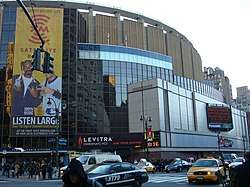Madison Square Garden
Madison Square Garden, colloquially known as The Garden or in initials as MSG, is a multi-purpose indoor arena in New York City. Located in Midtown Manhattan between 7th and 8th Avenues from 31st to 33rd Streets, it is situated atop Pennsylvania Station. It is the fourth venue to bear the name "Madison Square Garden"; the first two (1879 and 1890) were located on Madison Square, on East 26th Street and Madison Avenue, with the third Madison Square Garden (1925) further uptown at Eighth Avenue and 50th Street.
"MSG", "The Garden" | |
 | |
_-_Full_(48124330357).jpg) | |
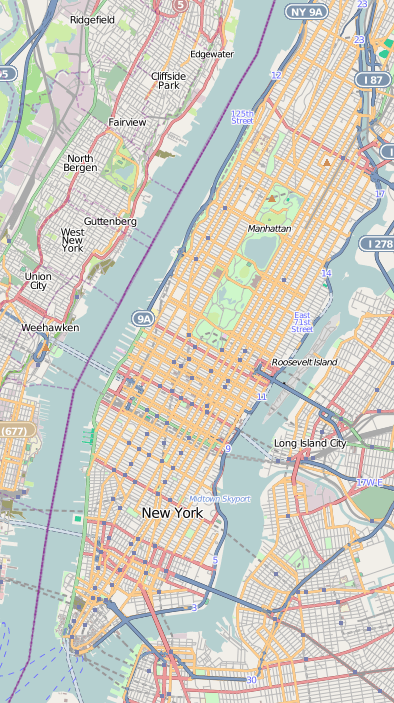 Madison Square Garden Location within Manhattan  Madison Square Garden Madison Square Garden (New York City)  Madison Square Garden Madison Square Garden (New York)  Madison Square Garden Madison Square Garden (the United States) | |
| Address | 4 Pennsylvania Plaza |
|---|---|
| Location | New York City, New York |
| Coordinates | 40°45′2″N 73°59′37″W |
| Public transit |
|
| Owner | The Madison Square Garden Company |
| Operator | MSG Entertainment |
| Capacity | Basketball: 19,812[1] Ice hockey: 18,006[1] Pro wrestling: 18,500 Concerts: 20,000 Boxing: 20,789 Hulu Theater: 5,600 |
| Field size | 820,000 sq ft (76,000 m2) |
| Construction | |
| Broke ground | October 29, 1964[2] |
| Opened | Former locations: 1879, 1890, 1925 Current location: February 11, 1968 |
| Renovated | 1989–1991, 2011–2013 |
| Construction cost | $123 million Renovation: 1991: $200 million Total cost: $1.07 billion in 2013 |
| Architect | Charles Luckman Associates Brisbin Brook Beynon Architects |
| Structural engineer | Severud Associates[3] |
| Services engineer | Syska & Hennessy, Inc.[4] |
| General contractor | Turner/Del E. Webb[4] |
| Tenants | |
| New York Rangers (NHL) (1968–present) New York Knicks (NBA) (1968–present) St. John's Red Storm (NCAA) (1969–present) New York Raiders/Golden Blades (WHA) (1972–1973) New York Apples (WTT) (1977–1978) New York Stars (WBL) (1979–1980) New York Cosmos (NASL) (1983–1984) New York Knights (AFL) (1988) New York CityHawks (AFL) (1997–1998) New York Liberty (WNBA) (1997–2010, 2014–2017) New York Titans (NLL) (2007–2009) | |
| Website | |
| www | |
The Garden is used for professional ice hockey and basketball, as well as boxing, concerts, ice shows, circuses, professional wrestling and other forms of sports and entertainment. It is close to other midtown Manhattan landmarks, including the Empire State Building, Koreatown, and Macy's at Herald Square. It is home to the New York Rangers of the National Hockey League (NHL), the New York Knicks of the National Basketball Association (NBA), and was home to the New York Liberty (WNBA) from 1997 to 2017.
Originally called Madison Square Garden Center, the Garden opened on February 11, 1968, and is the oldest major sporting facility in the New York metropolitan area. It is the oldest arena in the National Hockey League and the National Basketball Association. In 2016, MSG was the second-busiest music arena in the world in terms of ticket sales, behind The O2 Arena in London.[5] Including two major renovations, its total construction cost is approximately $1.1 billion, and it has been ranked as one of the 10 most expensive stadium venues ever built.[6] It is part of the Pennsylvania Plaza office and retail complex, named for the railway station. Several other operating entities related to the Garden share its name.
History
Previous Gardens
Madison Square is formed by the intersection of 5th Avenue and Broadway at 23rd Street in Manhattan. It was named after James Madison, fourth President of the United States.[7]
Two venues called Madison Square Garden were located just northeast of the square, the first from 1879 to 1890, and the second from 1890 to 1925. The first Garden, leased to P. T. Barnum,[8] had no roof and was inconvenient to use during inclement weather, so it was demolished after 11 years. Madison Square Garden II was designed by noted architect Stanford White. The new building was built by a syndicate which included J. P. Morgan, Andrew Carnegie, P. T. Barnum,[9] Darius Mills, James Stillman and W. W. Astor. White gave them a Beaux-Arts structure with a Moorish feel, including a minaret-like tower modeled after Giralda, the bell tower of the Cathedral of Seville[9] – soaring 32 stories – the city's second tallest building at the time – dominating Madison Square Park. It was 200 feet (61 m) by 485 feet (148 m), and the main hall, which was the largest in the world, measured 200 feet (61 m) by 350 feet (110 m), with permanent seating for 8,000 people and floor space for thousands more. It had a 1,200-seat theatre, a concert hall with a capacity of 1,500, the largest restaurant in the city and a roof garden cabaret.[8] The building cost $3 million.[8] Madison Square Garden II was unsuccessful like the first Garden,[10] and the New York Life Insurance Company, which held the mortgage on it, decided to tear it down in 1925 to make way for a new headquarters building, which would become the landmark Cass Gilbert-designed New York Life Building.
A third Madison Square Garden opened in a new location, on 8th Avenue between 49th and 50th Streets, from 1925 to 1968. Groundbreaking on the third Madison Square Garden took place on January 9, 1925.[11] Designed by the noted theater architect Thomas W. Lamb, it was built at the cost of $4.75 million in 249 days by boxing promoter Tex Rickard;[8] the arena was dubbed "The House That Tex Built."[12] The arena was 200 feet (61 m) by 375 feet (114 m), with seating on three levels, and a maximum capacity of 18,496 spectators for boxing.[8]
Demolition commenced in 1968 after the opening of the current Garden,[13] and was completed in early 1969. The site is now the location of One Worldwide Plaza.
Current Garden
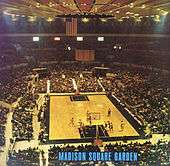
In February 1959, Graham-Paige purchased a 40% interest in the Madison Square Garden for $4 million[14] and later gained control.[15] In November 1960, Graham-Paige president Irving Mitchell Felt purchased from the Pennsylvania Railroad the rights to build at Penn Station.[16] To build the new facility, the above-ground portions of the original Pennsylvania Station were torn down.[17]
The new structure was one of the first of its kind to be built above the platforms of an active railroad station. It was an engineering feat constructed by Robert E. McKee of El Paso, Texas. Public outcry over the demolition of the Pennsylvania Station structure—an outstanding example of Beaux-Arts architecture—led to the creation of the New York City Landmarks Preservation Commission. The venue opened on February 11, 1968. Comparing the new and the old Penn Station, Yale architectural historian Vincent Scully wrote, "One entered the city like a god; one scuttles in now like a rat."[18]
In 1972, Felt proposed moving the Knicks and Rangers to a then incomplete venue in the New Jersey Meadowlands, the Meadowlands Sports Complex. The Garden was also the home arena for the NY Raiders/NY Golden Blades of the World Hockey Association. The Meadowlands would eventually host its own NBA and NHL teams, the New Jersey Nets and the New Jersey Devils, respectively. The New York Giants and Jets of the National Football League (NFL) also relocated there. In 1977, the arena was sold to Gulf and Western Industries. Felt's efforts fueled controversy between the Garden and New York City over real estate taxes. The disagreement again flared in 1980 when the Garden again challenged its tax bill. The arena, since the 1980s, has since enjoyed tax-free status, under the condition that all Knicks and Rangers home games must be hosted at MSG, lest it lose this exemption. As such, when the Rangers have played neutral-site games—even those in New York City, such as the 2018 NHL Winter Classic, they have always been designated as the visiting team.[19]
Garden owners spent $200 million in 1991 to renovate facilities and add 89 suites in place of hundreds of upper-tier seats. The project was designed by Ellerbe Becket. In 2004–2005, Cablevision battled with the City of New York over the proposed West Side Stadium, which was cancelled. Cablevision then announced plans to raze the Garden, replace it with high-rise commercial buildings, and build a new Garden one block away at the site of the James Farley Post Office. Meanwhile, a new project to renovate and modernize the Garden completed phase one in time for the Rangers and Knicks' 2011–12 seasons,[20] though the vice president of the Garden says he remains committed to the installation of an extension of Penn Station at the Farley Post Office site. While the Knicks and Rangers were not displaced, the New York Liberty played at the Prudential Center in Newark, New Jersey during the renovation.
Madison Square Garden is the last of the NBA and NHL arenas to not be named after a corporate sponsor.[21]
Joe Louis Plaza
In 1984, the four streets immediately surrounding the Garden were designated as Joe Louis Plaza, in honor of boxer Joe Louis, who made eight successful title defenses in the previous Madison Square Garden.[22][23]
2011–2013 renovation
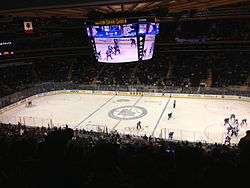
Madison Square Garden's $1 billion second renovation took place mainly over three offseasons. It was set to begin after the 2009–10 hockey/basketball seasons, but was delayed until after the 2010–11 seasons. Renovation was done in phases with the majority of the work done in the summer months to minimize disruptions to the NHL and NBA seasons. While the Rangers and Knicks were not displaced,[24][25] the Liberty played their home games through the 2013 season at Prudential Center in Newark, New Jersey, during the renovation.[26][27]
New features include a larger entrance with interactive kiosks, retail, climate-controlled space, and broadcast studio; larger concourses; new lighting and LED video systems with HDTV; new seating; two new pedestrian walkways suspended from the ceiling to allow fans to look directly down onto the games being played below; more dining options; and improved dressing rooms, locker rooms, green rooms, upgraded roof, and production offices. The lower bowl concourse, called the Madison Concourse, remains on the 6th floor. The upper bowl concourse was relocated to the 8th floor and it is known as the Garden Concourse. The 7th floor houses the new Madison Suites and the Madison Club. The upper bowl was built on top of these suites. The rebuilt concourses are wider than their predecessors, and include large windows that offer views of the city streets around the Garden.[28]
Construction of the lower bowl (Phase 1) was completed for the 2011–12 NHL season and the 2011–12 NBA lockout shortened season. An extended off-season for the Garden permitted some advanced work to begin on the new upper bowl, which was completed in time for the 2012–13 NBA season and the 2012–13 NHL lockout-shortened NHL season. This advance work included the West Balcony on the 10th floor, taking the place of sky-boxes, and new end-ice 300 level seating. The construction of the upper bowl along with the Madison Suites and the Madison Club (Phase 2) were completed for the 2012–13 NHL and NBA seasons. The construction of the new lobby known as Chase Square, along with the Chase Bridges and the new scoreboard (Phase 3) were completed for the 2013–14 NHL and NBA seasons.
Penn Station renovation controversy
Madison Square Garden is seen as an obstacle in the renovation and future expansion of Penn Station, which is already expanding through the James Farley Post Office, and some have proposed moving MSG to other sites in western Manhattan. On February 15, 2013, Manhattan Community Board 5 voted 36–0 against granting a renewal to MSG's operating permit in perpetuity and proposed a 10-year limit instead in order to build a new Penn Station where the arena is currently standing. Manhattan borough president Scott Stringer said, "Moving the arena is an important first step to improving Penn Station." The Madison Square Garden Company responded by saying that "[i]t is incongruous to think that M.S.G. would be considering moving."[29]
In May 2013, four architecture firms – SHoP Architects, SOM, H3 Hardy Collaboration Architecture, and Diller Scofidio + Renfro – submitted proposals for a new Penn Station. SHoP Architects recommended moving Madison Square Garden to the Morgan Postal Facility a few blocks southwest, as well as removing 2 Penn Plaza and redeveloping other towers, and an extension of the High Line to Penn Station.[30] Meanwhile, SOM proposed moving Madison Square Garden to the area just south of the James Farley Post Office, and redeveloping the area above Penn Station as a mixed-use development with commercial, residential, and recreational space.[30] H3 Hardy Collaboration Architecture wanted to move the arena to a new pier west of Jacob K. Javits Convention Center, four blocks west of the current station and arena. Then, according to H3's plan, four skyscrapers would be built, one at each of the four corners of the new Penn Station superblock, with a roof garden on top of the station; the Farley Post Office would become an education center.[30] Finally, Diller Scofidio + Renfro proposed a mixed-use development on the site, with spas, theaters, a cascading park, a pool, and restaurants; Madison Square Garden would be moved two blocks west, next to the post office. DS+F also proposed high-tech features in the station, such as train arrival and departure boards on the floor, and apps that would inform waiting passengers of ways to occupy their time until they board their trains.[30] Madison Square Garden rejected the notion that it would be relocated, and called the plans "pie-in-the-sky".[30]
In June 2013, the New York City Council Committee on Land Use voted unanimously to give the Garden a ten-year permit, at the end of which period the owners will either have to relocate, or go back through the permission process.[31] On July 24, the City Council voted to give the Garden a 10-year operating permit by a vote of 47–1. "This is the first step in finding a new home for Madison Square Garden and building a new Penn Station that is as great as New York and suitable for the 21st century," said City Council speaker Christine Quinn. "This is an opportunity to reimagine and redevelop Penn Station as a world-class transportation destination."[32]
In October 2014, the Morgan facility was selected as the ideal area for Madison Square Garden to be moved, following the 2014 MAS Summit in New York City. More plans for the station were discussed.[33][34] Then, in January 2016, New York Governor Andrew Cuomo announced a redevelopment plan for Penn Station that would involve the removal of The Theater at Madison Square Garden, but would otherwise leave the arena intact.[35][36]
Events
Regular events
Sports
Madison Square Garden hosts approximately 320 events a year. It is the home to the New York Rangers of the National Hockey League, and the New York Knicks of the National Basketball Association. The New York Rangers, New York Knicks, and the Madison Square Garden arena itself are all owned by the Madison Square Garden Company. The arena is also host to the Big East Men's Basketball Tournament and the finals of the National Invitation Tournament. It also hosts selected home games for the St. John's men's Red Storm (college basketball), and almost any other kind of indoor activity that draws large audiences, such as the Westminster Kennel Club Dog Show and the 2004 Republican National Convention.
The Garden was home of the NBA Draft and NIT Season Tip-Off, as well as the former New York City home of the Ringling Brothers and Barnum and Bailey Circus and Disney on Ice; all four events are now held at the Barclays Center in Brooklyn. It served the New York Cosmos for half of their home games during the 1983–84 NASL Indoor season.[37]
Many of boxing's biggest fights were held at Madison Square Garden, including the Roberto Durán–Ken Buchanan affair, the first Muhammad Ali – Joe Frazier bout and the US debut of Anthony Joshua that ended in a huge upset. Before promoters such as Don King and Bob Arum moved boxing to Las Vegas, Nevada, Madison Square Garden was considered the mecca of boxing. The original 18 1⁄2 ft × 18 1⁄2 ft (5.6 m × 5.6 m) ring, which was brought from the second and third generation of the Garden, was officially retired on September 19, 2007, and donated to the International Boxing Hall of Fame after 82 years of service.[38] A 20 ft × 20 ft (6.1 m × 6.1 m) ring replaced it beginning on October 6 of that same year.
Pro wrestling
Madison Square Garden has been considered the mecca for professional wrestling and the home of World Wrestling Entertainment (formerly WWF and WWWF).[39] The Garden has hosted three WrestleManias, more than any other arena, including the first edition of the annual marquee event for WWE, as well as the 10th and 20th editions. It also hosted the Royal Rumble in 2000 and 2008; SummerSlam in 1988, 1991 and 1998; as well as Survivor Series in 1996, 2002 and 2011.
New Japan Pro-Wrestling and Ring of Honor hosted their G1 Supercard supershow at the venue on April 6, 2019, which sold out in 19 minutes after the tickets went on sale.[40]A year later it was announced that New Japan Pro-Wrestling would return to Madison Square Garden alone on August 22, 2020 for NJPW Wrestle Dynasty.[41]
Concerts
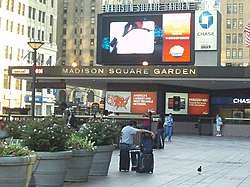

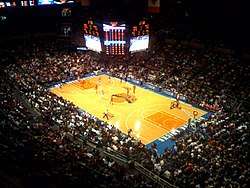
Madison Square Garden hosts more high-profile concert events than any other venue in New York City. It has been the venue for George Harrison's The Concert for Bangladesh, The Concert for New York City following the September 11 attacks, John Lennon's final concert appearance (during an Elton John concert on Thanksgiving Night, 1974) before his murder in 1980, and Elvis Presley, who gave four sold-out performances in 1972, his first and last ever in New York City. Parliament-Funkadelic headlined numerous sold-out shows in 1977 and 1978. Kiss, who were formed in the arena's city and three of whose members were city-born, did four shows at the arena in 1977 (their first ever there on February 18 and three more returning ones on December 14–16 the same year) and another two shows for a decade-ender in 1979 (July 24–25). Billy Joel, also city-born and fellow 1970's pop star did his first Garden show in 1978 on December 14. Led Zeppelin's three night stand in July 1973 was recorded and released as both a film and album titled The Song Remains The Same. The Police played their final show of their reunion tour at the Garden in 2008.
In the summer of 2017, Phish performed 13 consecutive concerts at the venue, which the Garden commemorated by adding a Phish themed banner to the rafters.[42] With their first MSG show taking place on December 30, 1994 the "Bakers' Dozen" brought the total number of Phish shows there to 52. An additional 12 shows since (4 for each of Phish's annual New Year's Eve runs) brings their total MSG performances to 64.[43][44]
At one point, Elton John held the all-time record for greatest number of appearances at the Garden with 64 shows. In a 2009 press release, John was quoted as saying "Madison Square Garden is my favorite venue in the whole world. I chose to have my 60th birthday concert there, because of all the incredible memories I've had playing the venue."[45] Billy Joel, who broke the record, stated "Madison Square Garden is the center of the universe as far as I'm concerned. It has the best acoustics, the best audiences, the best reputation, and the best history of great artists who have played there. It is the iconic, holy temple of rock and roll for most touring acts and, being a New Yorker, it holds a special significance to me."[45] Bob Marley and The Wailers have performed in the venue in 1978, 1979 and 1980 as part of Kaya Tour, Survival Tour and Uprising Tour respectively.
Grateful Dead have performed in the venue 53 times from 1979 to 1994 with the first show being held on September 7, 1979 and the last being on October 19, 1994. Their longest run being done in September 1991.[46]
Madonna performed at this venue a total of 31 concerts, the first two being during her 1985 Virgin Tour, on June 10 and 11, and the most recent being the two-nights stay during her Rebel Heart Tour on September 16 and 17, 2015.
Bruce Springsteen has performed 47 concerts at this venue, many with the E Street Band, including a 10-night string of sold-out concerts out between June 12 and July 1, 2000 at the end of the E Street Reunion tour.
U2 performed at the arena 28 times: the first one was on April 1, 1985 during their Unforgettable Fire Tour, in front of a crowd of 19,000 people. The second and the third were on September 28 and 29, 1987 during their Joshua Tree Tour, in front of 39,510 people. The fourth was on March 20, 1992 during their Zoo TV Tour, in front of a crowd of 18,179 people. The fifth, sixth, seventh, eighth and ninth was on June 17 and 19 and October 24, 25 and 27, 2001 during their Elevation Tour, in front of 91,787 people. The 10th, through 17th took place between May 21 and November 22, 2005 during their Vertigo Tour, in front of a total sold-out crowd of 149,004 people. The band performed eight performances at the arena in July 2015 as part of their Innocence + Experience Tour, and three performances in 2018 as part of their Experience + Innocence Tour.
The Who have headlined at the venue 32 times, including a four night stand in 1974, a five night stand in 1979, a six night stand in 1996, and four night stands in 2000 and 2002. They also performed at The Concert for New York City in 2001.[47]
On March 10, 2020 a 50th anniversary celebration of The Allman Brothers Band entitled 'The Brothers' took place featuring founding and surviving members of the band Jai Johanny Johanson and Chuck Leavell. Dickey Betts was invited to participate but his health precluded him from traveling. The concert was the last event to take place at The Garden before the 2020 coronavirus pandemic in North America forced the shutdown of major gatherings.[48]
Other events
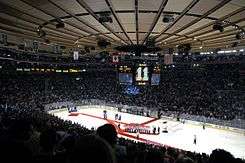
It has previously hosted the 1976 Democratic National Convention,[49] 1980 Democratic National Convention,[49] 1992 Democratic National Convention,[50] and the 2004 Republican National Convention,[51] and hosted the NFL Draft for many years (later held at Garden-leased Radio City Music Hall, now shared between cities of NFL franchises).[52][53] From 1982 to 1990, the Church of God in Christ in New York under the leadership of Bishop F.D. Washington used Madison Square Garden for its Annual Holy Convocation. Jeopardy Teen Tournament/Celebrity Jeopardy filmed at MSG in 1999 [54] and Wheel of Fortune in 1999 and 2013.[55][56]
The New York Police Academy,[57] Baruch College/CUNY and Yeshiva University also hold their annual graduation ceremonies at Madison Square Garden. It hosted the Grammy Awards in 1972, 1997, 2003 and 2018 (which are normally held in Los Angeles) as well as the Latin Grammy Awards of 2006.
The group and Best in Show competitions of the Westminster Kennel Club Dog Show have been held at MSG every February since 1877, making it MSG's longest continuous tenant.[58]
Notable firsts and significant events
The Garden hosted the Stanley Cup Finals and NBA Finals simultaneously on two occasions: in 1972 and 1994.
MSG has hosted the following All-Star Games:
- NHL All-Star Game: 1973, 1994
- NBA All-Star Game: 1998, 2015
- WNBA All-Star Game: 1999, 2003, 2006
UFC held its first event in New York City, UFC 205, at Madison Square Garden on November 12, 2016. This was the first event the organization held after New York State lifted the ban on mixed martial arts.
Recognition given by Madison Square Garden
Madison Square Garden Gold Ticket Award
In 1977 Madison Square Garden announced Gold Ticket Awards would be given to performers who had brought in more than 100,000 unit ticket sales to the venue. Since the arena's seating capacity is about 20,000, this would require a minimum of five sold-out shows. Performers who were eligible for the award at the time of its inauguration included Chicago, John Denver, Peter Frampton, the Rolling Stones, the Jackson 5, Elton John, Led Zeppelin, Sly Stone, Jethro Tull, The Who, and Yes.[59] [60] Graeme Edge, who received his award in 1981 as a member of The Moody Blues, said he found his gold ticket to be an interesting piece of memorabilia because he could use it to attend any event at the Garden.[61] Many other performers have received a Gold Ticket Award since 1977.
Madison Square Garden Platinum Ticket Award
Madison Square Garden also gave Platinum Ticket Awards to performers who sold over 250,000 tickets to their shows throughout the years. Winners of the Platinum Ticket Awards include: the Rolling Stones (1981),[62] Elton John (1982),[63] Yes (1984),[64] Billy Joel (1984),[65] and The Grateful Dead (1987).[66]
Madison Square Garden Hall of Fame
The Madison Square Garden Hall of Fame honors those who have demonstrated excellence in their fields at the Garden. Most of the inductees have been sports figures, however some performers have been inducted as well. Elton John was reported to be the first non-sports figure inducted into the MSG Hall of Fame in 1977 for "record attendance of 140,000" in June of that year.[67] For their accomplishment of "13 sell-out concerts" at the venue, the Rolling Stones were inducted into the MSG Hall of Fame in 1984, along with nine sports figures, bringing the hall's membership to 107.[68]
Madison Square Garden Walk of Fame
The walkway leading to the arena of Madison Square Garden was designated as the "Walk of Fame" in 1992.[69] It was established "to recognize athletes, artists, announcers and coaches for their extraordinary achievements and memorable performances at the venue."[70] Each inductee is commemorated with a plaque that lists the performance category in which his or her contributions have been made.[69] Twenty-five athletes were inducted into the MSG Walk of Fame at its inaugural ceremony in 1992, a black-tie dinner to raise money to fight multiple sclerosis.[71] Elton John was the first entertainer to be inducted into the MSG Walk of Fame in 1992.[72][73] Billy Joel was inducted at a date after Elton John,[74] and the Rolling Stones were inducted in 1998.[75] In 2015, the Grateful Dead were inducted into the MSG Walk of Fame along with at least three sports-related figures.[74][70]
Seating
Seating in Madison Square Garden was initially arranged in six ascending levels, each with its own color. The first level, which was available only for basketball games, boxing and concerts, and not for hockey games and ice shows, was known as the "Rotunda" ("ringside" for boxing and "courtside" for basketball), had beige seats, and bore section numbers of 29 and lower (the lowest number varying with the different venues, in some cases with the very lowest sections denoted by letters rather than numbers). Next above this was the "Orchestra" (red) seating, sections 31 through 97, followed by the 100-level "First Promenade" (orange) and 200-level "Second Promenade"(yellow), the 300-level (green) "First Balcony", and the 400-level (blue) "Second Balcony." The rainbow-colored seats were replaced with fuchsia and teal seats[76] during the 1990s renovation (in part because the blue seats had acquired an unsavory reputation, especially during games in which the New York Rangers hosted their cross-town rivals, the New York Islanders) which installed the 10th floor sky-boxes around the entire arena and the 9th floor sky-boxes on the 7th avenue end of the arena, taking out 400-level seating on the 7th Avenue end in the process.

Because all of the seats, except the 400 level, were in one monolithic grandstand, horizontal distance from the arena floor was significant from the ends of the arena. Also, the rows rose much more gradually than other North American arenas, which caused impaired sight lines, especially when sitting behind tall spectators or one of the concourses. This arrangement, however, created an advantage over newer arenas in that seats had a significantly lower vertical distance from the arena floor.
As part of the 2011–2013 renovation, the club sections, 100-level and 200-level have been combined to make a new 100-level lower bowl. The 300-level and 400-level were combined and raised 17 feet (5.2 m) closer, forming a new 200-level upper bowl. All skyboxes but those on the 7th Avenue end were removed and replaced with balcony seating (8th Avenue) and Chase Bridge Seating (31st Street and 33rd Street). The sky-boxes on the 9th floor were remodeled and are now called the Signature Suites. The sky-boxes on the 7th Avenue end of the 10th Floor are now known as the Lounges. One small section of the 400-level remains near the west end of the arena, and features blue seats. The media booths have been relocated to the 31st Street Chase Bridge.
Capacity
|
|
Hulu Theater
The Hulu Theater at Madison Square Garden seats between 2,000 and 5,600 for concerts and can also be used for meetings, stage shows, and graduation ceremonies. It was the home of the NFL Draft until 2005, when it moved to the Jacob K. Javits Convention Center after MSG management opposed a new stadium for the New York Jets. It also hosted the NBA Draft from 2001 to 2010. The theater also occasionally hosts boxing matches.
The fall 1999 Jeopardy! Teen Tournament as well as a Celebrity Jeopardy! competition were held at the theater. Wheel of Fortune taped at the theater twice in 1999 and 2013. In 2004, it was the venue of the Survivor: All-Stars finale. No seat is more than 177 feet (54 m) from the 30' × 64' stage. The theatre has a relatively low 20-foot (6.1 m) ceiling at stage level[79] and all of its seating except for boxes on the two side walls is on one level slanted back from the stage. There is an 8,000-square-foot (740 m2) lobby at the theater.
Accessibility and transportation
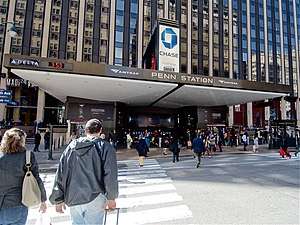
Madison Square Garden sits directly atop a major transportation hub in Pennsylvania Station, featuring access to commuter rail service from the Long Island Rail Road and New Jersey Transit, as well as Amtrak. The Garden is also accessible via the New York City Subway. The A, C, and E trains stop at 8th Avenue and the 1, 2, and 3 trains at 7th Avenue in Penn Station. The Garden can also be reached from nearby Herald Square with the B, D, F, <F>, M, N, Q, R, and W trains at the 34th Street – Herald Square station as well as PATH train service from the 33rd Street station.
See also
- Madison Square Garden Bowl, a former outdoor boxing venue in Queens operated by the Garden company
- List of NCAA Division I basketball arenas
References
Notes
- DeLessio, Joe (October 24, 2013). "Here's What the Renovated Madison Square Garden Looks Like". New York Magazine. Retrieved October 24, 2013.
- Seeger, Murray (October 30, 1964). "Construction Begins on New Madison Sq. Garden; Grillage Put in Place a Year After Demolition at Penn Station Was Started". The New York Times. Retrieved May 15, 2012.
- "Fred Severud; Designed Madison Square Garden, Gateway Arch". Los Angeles Times. June 15, 1990. Retrieved March 6, 2012.
- "New York Architecture Images- Madison Square Garden Center".
- "Pollstar Pro's busiest arena pdf" (PDF). Archived from the original (PDF) on March 3, 2017.
- Esteban (October 27, 2011). "11 Most Expensive Stadiums in the World". Total Pro Sports. Retrieved September 12, 2012.
- Mendelsohn, Joyce. "Madison Square" in Jackson, Kenneth T., ed. (1995). The Encyclopedia of New York City. New Haven: Yale University Press. ISBN 0300055366., p. 711–712
- "Madison Square Garden/The Paramount".
- Federal Writers' Project (1939). "New York City Guide". New York: Random House. ISBN 978-1-60354-055-1. (Reprinted by Scholarly Press, 1976; often referred to as WPA Guide to New York City.), pp. 330–333
- Burrows, Edwin G. and Wallace, Mike, Gotham: A History of New York to 1989. New York: Oxford University Press, 1999. ISBN 0-19-511634-8
- "Madison Square Garden III" on Ballparks.com
- Schumach, Murray (February 14, 1948).Next and Last Attraction at Old Madison Square Garden to Be Wreckers' Ball, The New York Times
- Eisenband, Jeffrey. "Remembering The 1948 Madison Square Garden All-Star Game With Marv Albert". ThePostGame. Retrieved July 5, 2015.
- "Investors Get Madison Sq. Garden". Variety. February 4, 1959. p. 20. Retrieved July 5, 2019 – via Archive.org.
- New York Times: "Irving M. Felt, 84, Sports Impresario, Is Dead" By AGIS SALPUKAS September 24, 1994
- Massachusetts Institute of Technology: "The Fall and Rise of Pennsylvania Station -Changing Attitudes Toward Historic Preservation in New York City" by Eric J. Plosky 1999
- Tolchin, Martin (October 29, 1963). "Demolition Starts At Penn Station; Architects Picket; Penn Station Demolition Begun; 6 Architects Call Act a 'Shame'". The New York Times. ISSN 0362-4331. Archived from the original on May 23, 2018. Retrieved May 22, 2018.
- Muschamp, Herbert (June 20, 1993). "Architecture View; In This Dream Station Future and Past Collide". The New York Times. ISSN 0362-4331. Archived from the original on September 6, 2018. Retrieved September 6, 2018.
- "Rangers on Road in the Bronx? Money May Be Why". New York Times. January 25, 2014. Retrieved January 3, 2017.
- Staple, Arthur (April 3, 2008). "MSG Executives Unveil Plan for Renovation". Newsday. Retrieved April 3, 2008.
- David Mayo (April 9, 2017). "With two arena closings in two days, Detroit stands unique in U.S. history". MLive. Retrieved April 21, 2017.
- John Eligon (February 22, 2008). "Joe Louis and Harlem, Connecting Again in a Police Athletic League Gym". New York Times. Retrieved September 26, 2015.
- Feirstein, Sanna (2001). Naming New York: Manhattan Places & how They Got Their Names. New York University Press. p. 110. Retrieved September 26, 2015.
- the Rangers started the 2011–12 NHL season with seven games on the road before playing their first hom game on October 27.Rosen, Dan (September 26, 2010). "Rangers Embrace Daunting Season-Opening Trip". National Hockey League. Retrieved October 3, 2011.
- The Knicks played the entire 2012 NBA preseason on the road.Swerling, Jared (August 2012). "Knicks preseason schedule announced". ESPN. Retrieved October 25, 2012.
- "Madison Square Garden – Official Web Site". Archived from the original on December 1, 2010.
- Bultman, Matthew; McShane, Larry (November 26, 2010). "Madison Square Garden to Add Pedestrian Walkways in Rafters as Part of $775 Million Makeover". New York Daily News. Retrieved July 3, 2011.
- Scott Cacciola (June 17, 2010). "Cultivating a New Garden". Wall Street Journal. Retrieved July 23, 2016.
- Dunlap, David (April 9, 2013). "Madison Square Garden Says It Will Not Be Uprooted From Penn Station". The New York Times. Retrieved April 10, 2013.
- Hana R. Alberts (May 29, 2013). "Four Plans for a New Penn Station Without MSG, Revealed!". Curbed. Retrieved October 26, 2014.
- Randolph, Eleanor (June 27, 2013). "Bit by Bit, Evicting Madison Square Garden". The New York Times. Retrieved July 8, 2013.
- Bagli, Charles (July 24, 2013). "Madison Square Garden Is Told to Move". The New York Times. Retrieved July 25, 2013.
- Hana R. Alberts (October 23, 2014). "Moving the Garden Would Pave the Way for a New Penn Station". Curbed. Retrieved October 26, 2014.
- "MSG & the Future of West Midtown". Scribd.
- Higgs, Larry (January 6, 2016). "Gov. Cuomo unveils grand plan to rebuild N.Y. Penn Station". The Star-Ledger. Retrieved January 6, 2016.
- "6th Proposal of Governor Cuomo's 2016 Agenda: Transform Penn Station and Farley Post Office Building Into a World-Class Transportation Hub". Governor Andrew M. Cuomo. Retrieved January 7, 2016.
- Yannis, Pat (March 8, 1984). "Hartford Shift Seen For Indoor Cosmos". New York Times. Retrieved December 22, 2016 – via newyorktimes.com.
- Baker, Mark A. (2019). Between the Ropes at Madison Square Garden, The History of an Iconic Boxing Ring, 1925–2007. ISBN 978-1476671833.
- Sullivan, Kevin (July 12, 2014). "Madison Square Garden really is the mecca of wrestling arenas". yesnetwork.com. Archived from the original on December 15, 2018. Retrieved December 15, 2018.
- "History has Been Made: ROH & New Japan Sell Out Madison Square Garden - PWInsider.com". www.pwinsider.com.
- "NJPW Returns to MSG for Wrestle Dynasty August 22 【NJoA】". New Japan Pro Wrestling. Archived from the original on February 10, 2020. Retrieved February 9, 2020.
- Jarnow, Jesse (August 7, 2017). "Phish's 'Baker's Dozen' Residency: Breaking Down All 13 Blissful Nights". Digiday. Retrieved August 9, 2017.
- "Phish to Hit 60 Madison Square Garden Shows With New Year's Eve Run". Billboard. September 21, 2018. Retrieved January 1, 2019.
- Bernstein, Scott. "Phish Announces New Year's Run 2019". Jambase.com. Archived from the original on December 6, 2019. Retrieved December 5, 2019.
- "Madison Square Garden and Radio City Music Hall Named 'Venue of the Decade' in Their Respective Categories by Billboard Magazine" (Press release). New York: Business Wire. MSG Entertainment. December 21, 2009. Retrieved April 28, 2017.
- , dead.net the official site of the grateful dead
- "The Who Concert Guide – Madison Square Garden". Retrieved January 11, 2019.
- Browne, David (March 19, 2020). "Derek Trucks on Playing Live Before and After the Coronavirus Shutdown". Rolling Stone. Retrieved April 30, 2020.
- Barrow, Bill (August 5, 2020). "Biden Won't Travel to Milwaukee to Accept Party's Nomination for President, Source Says". The Buffalo News.
- LOEVY, TOM CRONIN and BOB. "Do national conventions even matter anymore?". Colorado Springs Gazette. Retrieved August 6, 2020.
- Chung, Jen (August 30, 2019). "15 Years Ago, Protesters Took Over NYC During 2004 Republican National Convention". Gothamist. Retrieved August 6, 2020.
- Levy, Dan. "NFL Draft Is Moving in Wrong Direction". Bleacher Report. Retrieved August 6, 2020.
- "Future NFL Draft locations: Host cities for 2020 NFL Draft and beyond". www.sportingnews.com. Retrieved August 6, 2020.
- Kaplan, Don (October 11, 1999). "'JEOPARDY!' HITS NYC; GAME SHOW CHALLENGES 'MILLIONAIRE' ON ITS OWN TURF". New York Post. Retrieved August 6, 2020.
- Weinstein, Farrah (September 26, 1999). "STYLE & SUBSTANCE V-NN- WH-T-". New York Post. Retrieved August 6, 2020.
- "WHEEL OF FORTUNE to Tape at Madison Square Garden, 3/15-19; Shows Air May 2013". BroadwayWorld.com. Retrieved August 6, 2020.
- Formoso, Jessica (October 10, 2019). "NYPD welcomes new class of graduates". FOX 5 NY. Retrieved August 6, 2020.
- "Siba the Standard Poodle Wins the 2020 Westminster Dog Show With a Regal Attitude". Time. Retrieved August 6, 2020.
- "WNEW Gets Madison Square Garden Award" (PDF). Cash Box. Vol. XXXIX no. 25. George Albert. November 5, 1977. p. 16. Retrieved March 30, 2019 – via americanradiohistory.com.
- "Box Office Gold Ticket". Billboard. Vol. 89 no. 43. Lee Zhito. October 29, 1977. p. 42. Retrieved March 30, 2019 – via Google books.
- "Graeme Edge Interview with Glide Magazine". The Moody Blues. February 10, 2014. Retrieved March 30, 2019.
- "Rolling Stones inducted into Hall". The Central New Jersey Home News. New Brunswick, New Jersey, USA. June 14, 1984. p. 14, On the Go! section. Retrieved April 6, 2019 – via Newspapers.com.

- "Elton gets award". Tampa Bay Times. St. Petersburg, Florida, USA. August 7, 1982. p. 6A. Retrieved April 6, 2019 – via Newspapers.com.

- "Yes, that's quite a feat". Daily News. New York, New York, USA. May 16, 1984. p. 83. Retrieved April 6, 2019 – via Newspapers.com.

- "Hot Ticket". The Desert Sun. Palm Springs, California, USA. July 7, 1984. p. D12. Retrieved April 6, 2019 – via Newspapers.com.

- Jaeger, Barbara (October 1, 1987). "Records, Etc.: The Grateful Dead". The Record. Hackensack, New Jersey, USA. p. E-10. Retrieved April 5, 2019 – via Newspapers.com.

- "Elton in Manhattan" (PDF). Billboard. Vol. 89 no. 43. Lee Zhito. October 29, 1977. p. 3. Retrieved April 2, 2019 – via AmericanRadioHistory.com.
- Thomas Jr., Robert MCG. (May 7, 1984). "Sports World Specials". The New York Times. ISSN 0362-4331. Retrieved April 2, 2019.
- "Madison Square Garden Guide". CBS New York. October 19, 2010. Retrieved May 23, 2019.
- Bernstein, Scott (May 11, 2015). "Grateful Dead Inducted into MSG Walk of Fame". JamBase. Retrieved April 16, 2019.
- "Madison Square Garden Gets Walk of Fame". The Seattle Times. Seattle, Washington, USA. Associated Press. September 12, 1992. Retrieved April 16, 2019.
- "This Day in History: October 9: Also on this date in: 1992". Cape Breton Post. Sydney, Nova Scotia, Canada. October 9, 2010. Retrieved April 16, 2019 – via PressReader.
- Gregory, Andy, ed. (2002). International Who's Who in Popular Music 2002. London, England: Europa Publications. p. 260 See entry "John Elton (Sir)". ISBN 9781857431612.
- Biese, Alex (May 15, 2015). "Long, strange trip to NYC". The Courier-News. Bridgewater, New Jersey, USA. p. 2, Kicks section. Retrieved April 16, 2019 – via Newspapers.com.

- "Artists & Music: Walk This Way" (PDF). Billboard. Howard Lander. February 14, 1998. p. 12. Retrieved April 16, 2019 – via AmericanRadioHistory.
- Olshan, Jeremy (May 12, 2011). "Seats up first as MSG starts selling memorabilia".
- "2011–2012 New York Knicks Media Guide". Cite journal requires
|journal=(help) - "2011–2012 New York Rangers Media Guide". Cite journal requires
|journal=(help) - "Wintuk created exclusively for Wamu Theater at Madison Square Garden" Archived March 27, 2009, at the Wayback Machine, cirquedusoleil.com, November 7, 2007
Other sources
- McShane, Larry. "Looking Back at 125 Years of Madison Square Garden". New York City. Archived from the original on August 30, 2005. Retrieved August 7, 2005.
- "MSG: Corporate Information". Archived from the original on August 6, 2005. Retrieved August 7, 2005.
- "Rent The Garden". Archived from the original on March 5, 2005. Retrieved August 7, 2005.
- Bagli, Charles V. (September 12, 2005). "Madison Square Garden's Owners Are in Talks to Replace It, a Block West". The New York Times.
- Huff, Richard (August 22, 2006). "Arena's the Star of MSG Revamp". New York Daily News.
- Anderson, Dave (February 19, 1981). "Sports of the Times; Dues for the City". The New York Times.
- "A Garden Built For Tomorrow," Sports Illustrated, January 2, 1967.
- Madison Square Garden under construction from the Hagley Digital Archives
External links
| Wikimedia Commons has media related to Madison Square Garden. |
